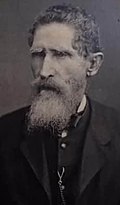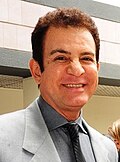Top Qs
Timeline
Chat
Perspective
Demographics of Honduras
From Wikipedia, the free encyclopedia
Remove ads
This article is about the ethnic groups and population of Honduras.
Remove ads
Population size and structure
Summarize
Perspective
According to the 2022 revision of the World Population Prospects[3][4] the total population was 10,278,345 in 2021, compared to 1,487,000 in 1950 (a fivefold increase in 60 years). The proportion of the population aged below 15 in 2010 was 36.8%, 58.9% were aged between 15 and 65 years of age, and 4.3% were aged 65 years or older.[5]
As of 2014, 60% of Hondurans live below the poverty line.[6] More than 30% of the population is divided between the lower middle and upper middle class, less than 10% are wealthy or belong to the higher social class (most live in Tegucigalpa and San Pedro Sula).
Structure of the population
Population Estimates by Sex and Age Group (01.VII.2007) (Data refer to projections based on the 2001 Population Census.):[7]
Population Estimates by Sex and Age Group (01.VII.2010) (Data refer to projections based on the 2001 Population Census.):
Population by Sex and Age Group (Census 10.VIII.2013): [8]
Population Estimates by Sex and Age Group (01.VII.2021) (Projections based on the 2013 Population Census.): [9]
Remove ads
Vital statistics
Summarize
Perspective
UN estimates
Registration of vital events is in Honduras not complete. The Population Department of the United Nations prepared the following estimates. [5]
This graph was using the legacy Graph extension, which is no longer supported. It needs to be converted to the new Chart extension. |
This graph was using the legacy Graph extension, which is no longer supported. It needs to be converted to the new Chart extension. |
Demographic and Health Surveys
Total Fertility Rate (TFR) (Wanted Fertility Rate) and Crude Birth Rate (CBR):[12]
Remove ads
Ethnic groups
Summarize
Perspective
Racial groups in Honduras (2013 census)[1]
- Mestizos (82.9%)
- Whites (7.87%)
- Indigenous (7.25%)
- Blacks (1.39%)
- Others (0.24%)
Amerindian
The Amerindian population is the largest minority group in Honduras. The largest Amerindian group are the Lencan people. These people have been living in Honduran territory since before the colonization of the Americas, developing their own societies and civilizations. They still have many communities across the country. The indigenous population would begin to decline from the mid-16th century, mainly due to the various diseases brought by the Europeans in addition to the growing mestizo population after the founding of towns and cities. According to the 2001 census the Amerindian population in Honduras included 381,495 people (6.3% of the total population).[13] With the exception of the Lenca and the Ch'orti' they still keep their language.
Six different Amerindian groups were counted at the 2001 census:
- the Lenca (279,507 in 2001;4.6% of the total population) living in the La Paz, Intibucá, and Lempira departments;
- the Miskito (51,607 in 2001; 0.8%) living on the northeast coast along the border with Nicaragua.
- the Ch'orti' (34,453 in 2001;0.6% of the total population), a Mayan group living in the northwest on the border with Guatemala;
- the Tolupan (also called Jicaque, "Xicaque", or Tol; 9,617 in 2001; 0.2% of the total population), living in the reserve of the Montaña de la Flor and parts of the department of Yoro;
- the Pech or Paya Indians (3,848 in 2001; 0.1% of the total population) living in a small area in the Olancho department;
- the Mayangna or Tawahka (2,463 in 2001; <0.1%)
Examples of Honduran natives are the many Mayan rules of Copan and other Mayan cities, native chiefs such as Lempira and Cicumba, and environmental and feminist activist Berta Cáceres.
- Copan founder, king Knich Yax Kuk Moo
- Mayan ruler, Kʼakʼ Yipyaj Chan Kʼawiil
- Lencan ruler, Lempira
- Lencan environmental activist, Berta Cáceres
Mestizos
Mestizos (meaning mixed European and Amerindian) have been reported by the CIA World Factbook to be about 87% of the population of Honduras.[14] As in other Latin American countries, the question of racial breakdown of a national population is contentious. Since the beginning of the 20th century at least, Honduras has publicly framed itself as a mestizo nation, along with other Latin American countries such as Guatemala or Mexico, ignoring and at times disparaging both the European component of the population and the surviving Amerindian population that was still regarded as "pure blooded". It's well known that many Hondurans of European or almost entirely Amerindian background consider themselves mestizo.[15][16]
Because of social stigmas attached, many Honduran people denied having African ancestry, and after African descended Caribbean workers arrived in Honduras, an active campaign to denigrate all people of African descent, made persons of mixed race anxious to deny any African ancestry. Hence official statistics quite uniformly under-represent those people who have ancestry in favor of a "two race" solution.[15]
A genetic admixture study focusing on kidney disease in Hispanic populations in the United States found an average genetic mix of 40% European, 39% Indigenous, and 21% African ancestry in the Honduran-American diaspora population, from a sample of 295 US residents who reported all four grandparents born in Honduras.[17]
Examples of Honduran mestizos are, Poet Clementina Suarez, novelist and poet Roberto Sosa, footballer Noel Valladares and former president Manuel Zelaya.
- Jose Trinidad Reyes, Founder of the National University
- Writer and poet, Rigoberto Paredes.
- Novelist, Roberto Sosa
- Footballer, Noél Valladares
African
The Afro-Honduran population consist of people of Afro-Descendants with roots in colonial Honduras, Garifuna, Miskito, and Creoles. Most of them are descendants of African people brought by the Spanish and other European colonizers between the 16th and 18th centuries. Many of them came from the west African coast, from places like Angola or Senegambia, where European bought slaves for their colonies, while others came from the other colonies in the Caribbean.
According to some reports around 230,000 enslaved Africans arrived to Honduras during colonial times, directly from Africa and other colonies in the Americas.
Scholars and private universities claim ranges from 20-30% of the Honduran population being Afro-descendants due to many Black Hondurans or Afro-descendants, Mulattos, Afro-Indigenous and people with significant African descent identifying as Mestizo due to oppression from society and the government and Mestizaje, wide-spread mixing amongst other things.
- The Miskito are an Afro-indigenous ethnic group in Central America, of whom many are mixed race. In the northern end of their territory, the people are primarily of African-Native American ancestry; others are of mixed African-Native American and English descent. Their territory extends from Cape Camarón, Honduras, to Río Grande de Matagalpa, Nicaragua, along the Mosquito Coast, in the Western Caribbean Zone.
- The Garifuna are descendants of Carib, Arawak, and West African people. This ethnic group has its origins in a group from St. Vincent islands in the Caribbean, who came in 1797. At the 2001 census 46,448 people were registered as Garifuna, 0.8% of the total population of Honduras.[13] The Garifuna speak an Arawakan language. They live along the entire Caribbean coastline of Honduras, and in the Bay Islands.
- The Creole people are descendants of Afro-Caribbean people who arrived originally with the introduction of enslaved Africans brought by the British to Honduras in the 16th and 17th century. Creoles also arrived with the immigration of black workers from Jamaica, Cayman Island, Trinidad and Tobago and other English-speaking islands, who arrived in the early twentieth century to work in transnational banana companies, workers in the construction of railways, dockworkers and in some cases "scabs", are concentrated mainly in the Bay Islands, especially the Roatan Island and Guanaja and Caribbean coastal Honduran cities like Puerto Cortes, Tela and La Ceiba. In the 1800s, five years before independence, the Mayor Don Juan Antonio Tomos issued a report of his visit in 1815, in which he indicated 100,000 inhabitants in the cities of Puerto Cortés, San Pedro Sula, Tela, La Ceiba, and 39 curatos and 8 villages of Caribbean blacks from countries like Jamaica, Trinidad and Tobago, Saint Lucia, Belize, and Haiti. Plus additional inhabitants near Trujillo (estimate does at 10,000) for a total of 110,000 inhabitants. After independence" the population of 1826 (200,000 people) is based on the calculation made by Mr. Dionisio de Herrera, former head of the state of Honduras. By the early 1900s more 300,000 people had came to Honduras to work mainly in the booming banana cultivation and other agricultural sectors.
Examples of well-known Afro-Hondurans are footballers David Suazo, Victor "Muma" Bernardez, Dr. Emet Cherefant, and Wilson Palacios.
- Footballer, David Suazo
- Footballer, Wilson Palacios
European
Honduras of European descent or White Hondurans, along with Afro-descendants and Amerindians belong to the minorities of Honduras. Most of the white population are descendants of the Spanish settlers, who mainly came from southern Spain, and inhabit most of the western part of the country. Other populations include descendants of European immigrants who arrived at the beginning of the 20th century. In 2014, there were about 14,000 Hondurans of Italian descent, while there were around 400 Italian citizens.[18] Percentages of whites varied between 2.1% and 7%,[19] due to the fact that the majority of Hondurans identify themselves as mestizos, regardless of their ethnic and racial category.[20] This makes it more difficult to study the number of people who fit into the white category in Honduras.
The census states that only 89,000 people in Honduras labeled themselves as white, which is equal to around 1% of the total population at the time.[21] Another study has stated that around 210,000 people in Honduras fit this category, which would make the Honduran white population to be around 2.1%.[citation needed]
However, other studies report that the percentage could rise much more, reaching close to a half a million white people in Honduras, which according to official national sources would make a percentage of between 5% and 6.9% of whites in Hondurans.[22] This is because the majority of whites in Honduras do not identify themselves as Euro-descendants as such, adopting and feeling more identified with the mestizo identity.[23]
Examples of white Hondurans are ex-president Simon Azcona del Hoyo, pharmacologist Salvador Moncada, film director Juan Carlos Fanconi, politician Roberto Micheletti, General Florencio Xatruch and former president of the Central American federation Don Francisco Morazán Quezada.
- Central American president, General Francisco Morazán
- General, Florencio Xatruch
- Ex-President, Francisco Bertrand
- Sir. Salvador Moncada, Honduran pharmacologist
- Juan Carlos Fanconi, film director
- Ex president, José Simón Azcona del Hoyo
East Asians
There is a small Chinese community in Honduras. A lawyer of the Committee for the Defense of Human Rights in Honduras (CODEH) stated that the Chinese community in Honduras is rather small. Many of the Chinese are immigrants who arrived from China after the revolution and their descendants.[24]
- Hajime Waki, Honduran-Japanese singer.
Arabs
Honduras hosts a significant Palestinian community (the vast majority of whom are Christian Arabs).[25] These Arab-Hondurans are sometimes called "Turcos", because they arrived in Honduras using Turkish travel documents, as their homeland was then under the control of the Ottoman Empire. The Palestinians arrived in the country in the late 19th and early 20th centuries, establishing themselves especially in the city of San Pedro Sula.[26] As mentioned earlier, they are also considered whites in the country's censuses, in total the Arab-Hondurans make up 3% of the Honduran population.
- Businessman Miguel Facusse, son of immigrants from the Ottoman Empire
- TV host Salvador Nasralla, son of Palestinian immigrants
- Dr Kerim Gattas Asfura, of Arab descent
- Carlos Flores Facussé, first Honduran president of Palestinian descent
Remove ads
Religion
Religions: in Honduras %[14]
- Roman Catholic (46.0%)
- Protestant (39.0%)
See also
References
Wikiwand - on
Seamless Wikipedia browsing. On steroids.
Remove ads






















